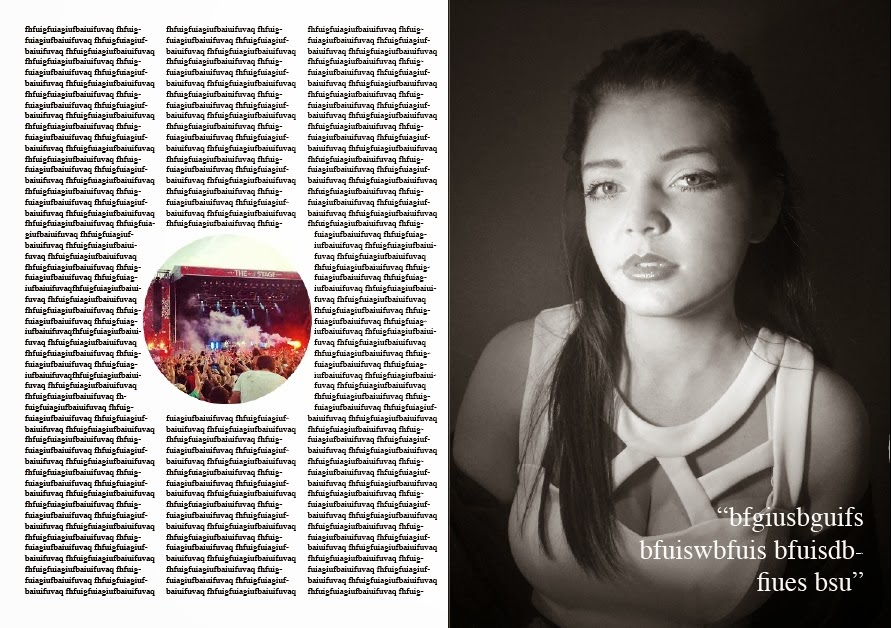Wednesday, 26 February 2014
Friday, 7 February 2014
Masthead / Typography analysis
Masthead / Typography Analysis
 NME also uses the idea of letters to represent other words and make a shorter, more memorable masthead. White capitalized initials are used in an orange/red rectangular box in the corner of the page; the colours work well together because they are so dissimilar, which makes the masthead easier to read.
NME also uses the idea of letters to represent other words and make a shorter, more memorable masthead. White capitalized initials are used in an orange/red rectangular box in the corner of the page; the colours work well together because they are so dissimilar, which makes the masthead easier to read.

Q magazine have a very simple masthead with simply a single white letter, with a red square box behind it. The serif font is quite formal as is has no embellishment which other magazines may have, and there is a drop shadow to make it less of a flat image. The idea of using one letter makes it easy to remember, and doesn't take up a large space on the front page.
Vibe magazine has a masthead which changes in colour depending on the image used for the front cover. It is a simple sans serif font, which stretches across the page, rather than being positioned in one corner or the middle. The genre of music is reflected in the masthead because the font has smooth lines, and does not connote any elements of a roughed up, edgy variety of music, such as indie.
 Kerrang's masthead is very different from Vibe,Q and NME's due its more thrown together, rough appearance. The font is white and has black lines through it to reflect both the strings of a guitar (an instrument frequently used by the artists in the rock genre), and smashed glass. The idea of smashed glass suits this genre as rock musicians are infamously impulsive, and often known to get into fights. The background of the masthead is black, a colour frequently associated with rock music due to bands wearing a lot of black, and the connotations with this colour mirror ideas raised by rock music.
Kerrang's masthead is very different from Vibe,Q and NME's due its more thrown together, rough appearance. The font is white and has black lines through it to reflect both the strings of a guitar (an instrument frequently used by the artists in the rock genre), and smashed glass. The idea of smashed glass suits this genre as rock musicians are infamously impulsive, and often known to get into fights. The background of the masthead is black, a colour frequently associated with rock music due to bands wearing a lot of black, and the connotations with this colour mirror ideas raised by rock music.
 NME also uses the idea of letters to represent other words and make a shorter, more memorable masthead. White capitalized initials are used in an orange/red rectangular box in the corner of the page; the colours work well together because they are so dissimilar, which makes the masthead easier to read.
NME also uses the idea of letters to represent other words and make a shorter, more memorable masthead. White capitalized initials are used in an orange/red rectangular box in the corner of the page; the colours work well together because they are so dissimilar, which makes the masthead easier to read. 
Q magazine have a very simple masthead with simply a single white letter, with a red square box behind it. The serif font is quite formal as is has no embellishment which other magazines may have, and there is a drop shadow to make it less of a flat image. The idea of using one letter makes it easy to remember, and doesn't take up a large space on the front page.
Vibe magazine has a masthead which changes in colour depending on the image used for the front cover. It is a simple sans serif font, which stretches across the page, rather than being positioned in one corner or the middle. The genre of music is reflected in the masthead because the font has smooth lines, and does not connote any elements of a roughed up, edgy variety of music, such as indie.
 Kerrang's masthead is very different from Vibe,Q and NME's due its more thrown together, rough appearance. The font is white and has black lines through it to reflect both the strings of a guitar (an instrument frequently used by the artists in the rock genre), and smashed glass. The idea of smashed glass suits this genre as rock musicians are infamously impulsive, and often known to get into fights. The background of the masthead is black, a colour frequently associated with rock music due to bands wearing a lot of black, and the connotations with this colour mirror ideas raised by rock music.
Kerrang's masthead is very different from Vibe,Q and NME's due its more thrown together, rough appearance. The font is white and has black lines through it to reflect both the strings of a guitar (an instrument frequently used by the artists in the rock genre), and smashed glass. The idea of smashed glass suits this genre as rock musicians are infamously impulsive, and often known to get into fights. The background of the masthead is black, a colour frequently associated with rock music due to bands wearing a lot of black, and the connotations with this colour mirror ideas raised by rock music.
Subscribe to:
Posts (Atom)



